| Home |
| For Teachers |
| For Parents |
| For Kids |
| Topics of Interest |
| Bullying Among Girls |
| Beyond the Bully-Victim Dyad |
| Resources |
| Contact Us |
Topics of Interest
Bullying Among Girls
Sticks and Stones, Anonymous
Until quite recently, the literature on bullying focused solely on physical
and verbal aggression. Since the 1990s, however, researchers have
also begun to examine relational aggression. Relational aggression
refers to any act that actively excludes a person from making or maintaining
friendships or being integrated into the peer group--such as spreading
rumors, or excluding and socially isolating a person (e.g., Bjoerkqvist,
Lagerspetz, & Kaukianen, 1992). Studies have found that while
boys tend to use overt forms of aggression (such as physical and verbal
aggression) in bullying, girls' bullying behaviors often focus on damaging an individual's social connections within the peer group (e.g., Crick & Grotpeter, 1995; Crick, Casas, & Ku, 1999).
Researchers are beginning to broaden their definitions of aggression and
bullying, and to examine the consequences of relational aggression for
all parties involved (e.g., Crick, 1996; Tomada & Schneider, 1997).
The topic of relational aggression has also captured the attention of the
general public, through such books as Rachel Simmons' (2002) Odd Girl Out.
This section is devoted to discussions exploring relational aggression,
and other topics related to bullying that are of special concern to girls.
Two reviews of Simmons' Odd Girl Out are also included. Female Bullying: Beyond the Bully-Victim Dyad / Cortney C. Rhadigan
A Review of Odd Girl Out: The Hidden Culture of Aggression in Girls
/ Rachel Legg
A Review of Odd Girl Out: The Hidden Culture of Aggression in Girls
/ Cristina Calcagno
References
Bjoerkqvist, K., Lagerspetz, K. M. J., & Kaukianen, A. (1992). Do
girls manipulate and boys fight? Developmental trends in regard to direct
and indirect aggression. Aggressive Behavior, 18, 117-127.
Crick, N. R., & Grotpeter, J. K. (1995). Relational aggression,
gender, and social-psychological adjustment. Child Development, 66,
710-722.
Crick, N. R. (1996). The role of overt aggression, relational
aggression, and prosocial behavior in the prediction of children's future
social adjustment. Child Development, 67, 2317-2327.
Crick, N. R., Casas, J. E., & Ku, H. (1999). Relational and
physical forms of peer victimization in preschool. Developmental Psychology,
35, 376-385.
Simmons, R. (2002). Odd girl out: The hidden culture of aggression
in girls. New York: Harcourt.
Tomada, G., & Schneider, B. H. (1997). Relational aggression, gender,
and peer acceptance. Developmental Psychology, 33, 601-609.
(Word
Version, PDF
Version)
(Word
Version, PDF
Version)
(Word
Version, PDF
Version)